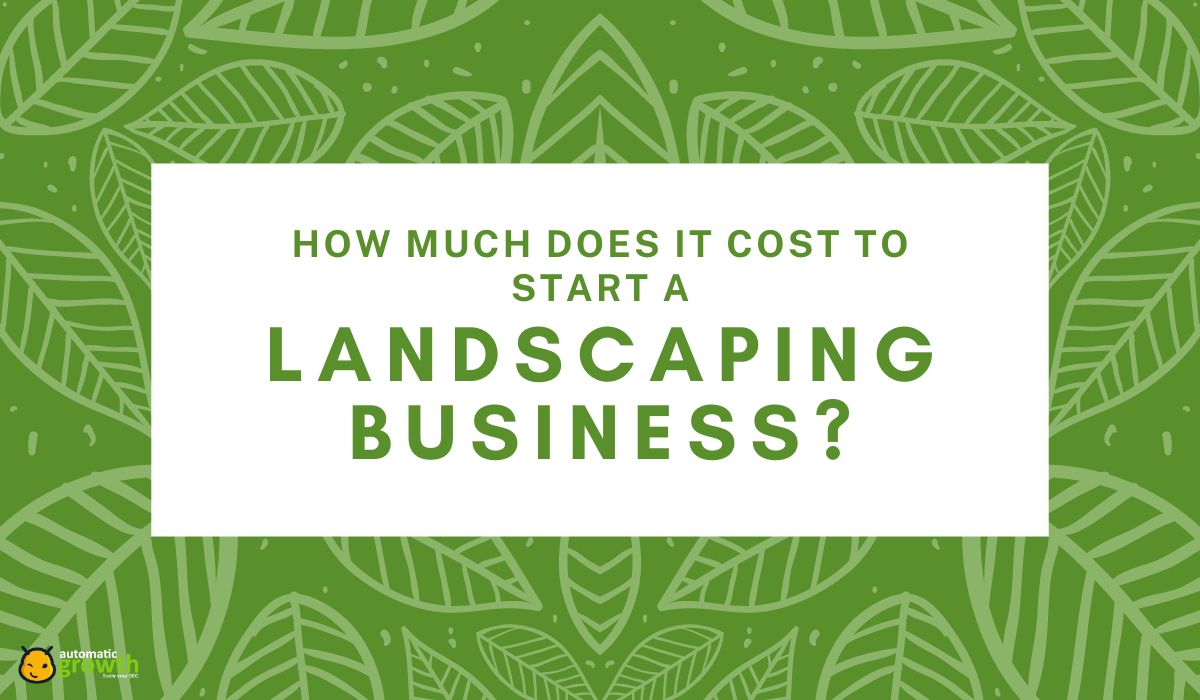Landscaping is more than just tending to gardens and lawn care — it's about crafting nature into art, turning spaces into sanctuaries, and transforming the mundane into the magnificent. But beyond the allure of verdant vistas and serene sceneries lies the practical question: How much does it cost to start a landscaping business?
Whether you're a green-thumbed enthusiast considering a professional shift or an entrepreneur eyeing the industry's potential, this guide will provide a comprehensive breakdown of the financial commitments required to start a landscaping business. Let’s dive in!
Average Costs of Starting a Landscape Business
Thinking about setting up your own landscaping business? That's great! But before you start buying tools or hiring people, you might be wondering: How much does it cost to start a landscaping business? Every new business has initial costs and monthly expenses, and knowing them beforehand can help you prepare for your financial commitment.
For landscaping, these costs can include things like equipment, wages for your workers, and marketing to get customers.
-
Starting Costs: To kick off your landscaping business with a team of 4 people, you'll need an amount between $39,500 and $43,500. This might cover things like buying equipment, getting any needed licenses, and paying your team for the first time.
-
Monthly Costs: After setting up, there are ongoing costs to keep your business running. For the first few months, you should plan for anywhere between $20,700 and $33,000 each month. This will cover salaries, fuel for vehicles, advertising, and other day-to-day expenses.
Startup Costs of a Landscape Business
Starting a landscape business can be a great opportunity for those who have a passion for the outdoors and enjoy working with plants and gardens. However, like any other business, there are startup costs that need to be considered. Here are the key startup costs for a landscape business:
1. Equipment
One of the primary expenses for a landscape business is the equipment needed to perform various tasks. This includes tools such as lawnmowers, trimmers, leaf blowers, shovels, rakes, and more. Depending on the scale of your business, you may also need larger equipment, such as tractors or excavators. It's important to invest in high-quality equipment that is durable and will last for a long time.
Here's a list of tools and equipment you might need, along with a rough idea of how much they might cost:
-
Basic gardening tools like shovels, rakes, and trowels: $10-$50 per tool
-
Standard push mower: $200-$1,000
-
Bigger riding mower: $1,000-$5,000
-
Machine to blow leaves (leaf blower): $100-$500
-
Tool to spread seeds or fertilizer (lawn spreader): $100-$500
-
Tool to spray things like plant food or bug spray (sprayer): $50-$200
-
Tool to cut long grass (trimmer): $50-$300
-
Tool to make neat edges on lawns (edger): $80-$350
-
Saw that uses water (water saw): $500-$4,000
-
Machine to press down soil or gravel (plate compactor): $300-$5,000
-
Trailer to carry tools and equipment: $1,500-$5,000
-
Big strong truck for heavy loads: $10,000-$50,000
-
Machine to make electricity (portable generator): $500-$2,000
2. Products
Another essential startup cost is the purchase of products such as plants, seeds, fertilizers, pesticides, and soil. These are necessary to maintain and enhance the landscapes of your clients. It's important to do thorough research and find reliable suppliers to ensure the quality of your products.
3. Vehicles
A landscape business often requires transportation for equipment and materials. This could range from small trucks or vans to larger trailers. The size and type of vehicle will depend on the scale of your business and the services you offer. Additionally, you may need to invest in vehicle signage or branding to promote your business while on the road.
4. Licenses and Legal Costs
To operate a landscape business, you may need to obtain certain licenses and permits depending on your local regulations. These can include a business license, contractor's license, pesticide application license, and more. It's important to research the specific requirements in your area and factor in the associated costs. Additionally, consulting with a lawyer to ensure compliance with all legal aspects can be beneficial.
5. Office and Warehouse Rent
Depending on the size of your business, you may need to consider renting office or warehouse space. This can serve as a central location for administrative tasks, storage of equipment and supplies, and meetings with clients. The cost of rent will vary depending on the location and size of the space. It's important to choose a location that is convenient for your employees and clients.
Monthly Operating Costs of a Landscape Business
In addition to the startup costs, it's important to keep track of your monthly operating costs to ensure the profitability and sustainability of your business. Understanding and managing these costs is crucial for making informed decisions and maximizing your revenue. Here are some key monthly operating costs that you should consider for your landscape business.
1. Staff
One of the major operating costs for any business is the wages and salaries of your employees. In the case of a landscape business, this includes the cost of hiring and maintaining a team of skilled workers, such as gardeners, landscapers, and maintenance crew. It's important to factor in the wages, benefits, and other related expenses when calculating your staff costs.
2. Fuel
As a landscape business, you'll likely have a fleet of vehicles and equipment that require fuel to operate. This includes trucks, lawnmowers, trimmers, and other machinery. Fuel costs can vary depending on the size of your business and the number of projects you undertake. Keeping track of fuel consumption and finding ways to optimize fuel efficiency can help minimize this expense.
3. Rent
If you operate from a physical location, such as an office or a storage facility, you need to consider the monthly rent or lease payments. This cost can significantly vary depending on the location and size of your premises. It's essential to evaluate the space you require and negotiate favorable rental terms to avoid unnecessary financial burden.
4. Repair and Maintenance
Equipment breakdowns and regular maintenance are inevitable in the landscape business. From repairing damaged tools to servicing your vehicles, these costs can add up over time. Setting aside a budget for repairs and maintenance ensures that your equipment remains in good working condition and helps prevent unexpected expenses.
5. Marketing
To attract new clients and grow your landscape business, you need to invest in marketing and advertising. This can include expenses for online advertising, website development, social media promotions, print materials, and more. Allocating a portion of your budget toward marketing efforts is vital to generating leads and maintaining a steady flow of projects.
Analyzing the Profitability of a Landscape Business
Starting a landscaping business can be rewarding, both in terms of personal satisfaction and potential income. But how profitable is it really? In 2022, the worldwide market for landscaping services was worth $296.09 billion. It's predicted to grow at a rate of 6.4% each year from 2023 to 2030. But despite this bright outlook, the landscape industry is also highly competitive.
Landscaping often provides opportunities for recurring revenue, such as lawn maintenance, which can be scheduled weekly or bi-weekly. Securing long-term contracts ensures steady income, which can stabilize profits.
The amount you charge for your services directly affects your profits. Research what competitors charge and consider the quality and uniqueness of your services. Always aim to offer value, as this can command higher prices.
The profitability of a landscaping business, like any other, relies on a delicate balance between revenue and expenses. By understanding the industry's nuances, managing costs effectively, and constantly adapting to market demands, a landscaping business can be a lucrative venture.
Frequently Asked Questions
1. How much does it cost to start a landscaping business?
Initial costs typically include equipment, vehicles, licenses and permits, office or warehouse rent, insurance, and marketing materials.
2. Will I need a vehicle for my landscape business?
Yes, most landscaping businesses require vehicles for transporting tools, plants, and staff. The cost of a vehicle can range from $5,000 for a used one to over $50,000 for a new, heavy-duty truck.
3. What are the licensing and legal costs associated with starting a landscape business?
Licensing costs can vary based on location but can range from $100 to $1,000. Additionally, insurance can cost between $500 and $2,000 annually, depending on coverage.
4. Are there any recurring costs to consider in a landscaping business?
Yes, besides rent, you'll have recurring costs for equipment maintenance, fuel, employee salaries, marketing, insurance renewals, and any product supplies like seeds or fertilizers.
5. Can I start my landscaping business from home to save on costs?
Yes, many entrepreneurs start their landscaping businesses from home to minimize initial expenses. However, ensure you have adequate storage space for tools and equipment.
Charting a Path in the Green Industry
Starting a landscape business can be a fulfilling venture, combining a passion for the outdoors with the desire to create beautiful spaces. The costs associated with kickstarting this dream are varied, but with careful planning and research, you can set yourself up for success.
As you lay the foundation for your landscaping business, consider another important aspect: your brand's identity.
Choosing a memorable name can set your flower shop apart and attract more customers. Need inspiration? Check out our curated list of flower shop business names to find the perfect fit for your blossoming business. Kickstart your green business today!
















